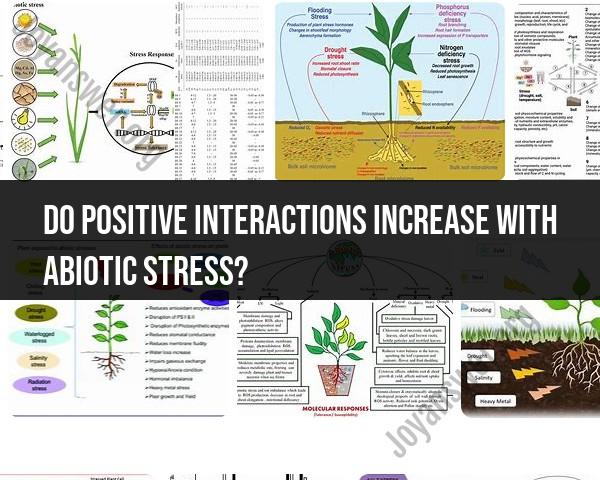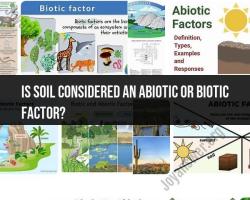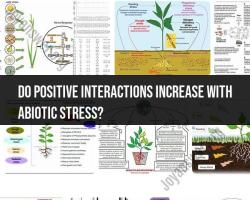Do positive interactions increase with abiotic stress?
The relationship between positive interactions (also known as facilitation) and abiotic stress in ecological systems can vary depending on the specific context, species involved, and the severity of the stress.
In some cases, abiotic stressors such as extreme temperatures, drought, or salinity can create harsh conditions that limit the growth and survival of individual organisms. Under these circumstances, positive interactions among species may become more prevalent as they help alleviate the stress and improve the overall resilience of the community. For example:
Nurse Plant Effect: In arid environments, larger plants (nurse plants) can provide shelter and shade for smaller, more sensitive species, allowing them to survive in otherwise inhospitable conditions.
Mutualistic Relationships: Mutualistic interactions, where two species benefit from each other's presence, can become more important under abiotic stress. For instance, certain mycorrhizal fungi can help plants acquire nutrients and water from the soil, enhancing their ability to withstand drought.
Facilitation by Physical Structures: Some species may create physical structures or microhabitats that buffer against abiotic stressors. For example, the presence of biological crusts in deserts can stabilize soil, reduce erosion, and improve water retention, benefiting other organisms in the environment.
However, it's important to note that the relationship between positive interactions and abiotic stress is not always straightforward and can vary depending on factors such as the intensity and duration of the stress, the competitive dynamics within the community, and the adaptability of species to the stressor.
In certain cases, severe abiotic stress may overwhelm any facilitative effects, leading to a decline in positive interactions and an overall reduction in community diversity and productivity. Additionally, some species may respond to stress by prioritizing individual survival over cooperation, which can inhibit the occurrence of positive interactions.
Overall, while positive interactions can play an important role in mitigating the effects of abiotic stress in ecological systems, the outcome depends on a complex interplay of factors, and generalizations may not always hold true across different ecosystems and scenarios.
The relationship between abiotic stress and positive interactions in organisms is complex and can vary depending on the specific environment, organisms involved, and type of stress. Here's a breakdown:
1. Do positive interactions increase during abiotic stress?
There's no simple yes or no answer. Studies have shown different outcomes:
- Increase: In some cases, abiotic stress like drought or high temperatures can lead to increased cooperation and facilitation between organisms. For example, plants may share resources through their root systems or provide shade to one another. Sharing resources or sheltering together improves survival chances under harsh conditions.
- Decrease: In other cases, stress can lead to increased competition and aggression. When resources become scarce, organisms may fight for them, leading to decreased positive interactions.
- Mixed effects: Sometimes, both positive and negative interactions may increase under stress, depending on the specific context and organisms involved.
2. How do organisms respond to abiotic stress and does it influence social behaviors?
When facing abiotic stress, organisms prioritize survival. Their responses can include:
- Physiological changes: Adjusting metabolism, water use, or heat tolerance.
- Behavioral changes: Seeking shelter, foraging in different areas, or migrating.
- Social changes: Modifying their interactions with other organisms.
These changes, including social ones, are driven by factors like resource availability, predation risk, and the potential benefits of cooperation. Stress can alter these factors, influencing how organisms interact with each other.
3. Are there studies supporting the correlation?
Yes, several studies provide evidence for both positive and negative impacts of abiotic stress on social interactions:
- Positive:
- A study on alpine plants showed that under high stress, positive interactions like providing shelter increased, likely enhancing survival.
- Research on fish found that during drought, they formed larger schools for protection, showing increased cooperation under stress.
- Negative:
- A study on desert rodents observed increased aggression and competition for food during periods of drought.
- Research on birds showed that territorial behavior intensified under competition for limited resources due to stress.
Conclusion:
The relationship between abiotic stress and positive interactions is multifaceted and context-dependent. While some stressful situations encourage cooperation, others intensify competition. Understanding these complex dynamics is crucial for predicting species' responses to environmental changes and their long-term survival.




